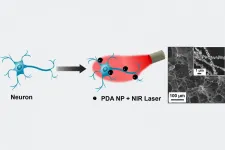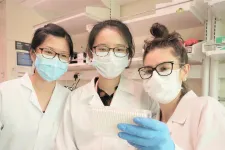(Press-News.org) A new study of almost 12,000 Australians has found one-third of the adult population has experienced pure cybercrime during their lifetime, with 14% reporting this disruption to network systems in the past 12 months.
With all forms of cybercrime already costing trillions every year globally, experts from the Australian Institute of Criminology (AIC) and Flinders University say the crimes involved substantial levels of personal victimisation including direct losses as well as the high cost of preventing future attacks.
A pre-COVID-19 snapshot of the cost of 'pure cybercrime' in 2019 has found an approximate total economic hit of $3.5 billion - comprising $1.4 billion spent on prevention costs, $1.9 billion in money directly lost by victims and $597 million spent dealing with the consequences of victimisation.
With only about $389 million recovered by victims - barely paying for the cost of dealing with the incidents - the survey estimated about 2.8 million Australians had been hit within the past year and nearly 6.7 million Australian adults could have been victims at any time in the past.
Only a small proportion of financial losses are recovered by victims.
'Pure cybercrime' activities include hacking, spreading viruses and other malware, and distributed denial-of-service attacks. While this involves crimes against machines and networks, it is estimated other forms of cyber-enabled identity crime cost Australian government agencies, individuals and businesses additional sums of more than $3bn a year.
"Pure cybercrime is a highly profitable criminal activity and results in substantial financial losses to Australians," says Flinders University Professor Russell Smith, who also warns of a potential rise in online fraud as a result of opportunities for dishonesty created by COVID-19-related economic disruptions.
"On current information, as cybercriminals become more sophisticated, it's clear the need for additional expenditure on prevention will need to increase.
"Equally, it is imperative that the financial harms associated with cybercrime are assessed so that resources for prevention and response activities can be targeted most effectively, and a baseline can be developed against which to measure the impact of future policy responses," Professor Smith says.
A 2018-2019 investigation into identity crime (Smith & Franks 2020) found a cost of $3.1 billion to Commonwealth entities, state and territory agencies (including police), individuals and businesses - most of which, but not all, was a consequence of cyber-enabled identity crime.
Cyber-enabled offences use technology to make conventional crimes such as identity theft, fraud, stalking and harassment easier to commit and with a lower risk of detection.
"Cybercrime is a growing, borderless and continually evolving body of crimes which can threaten individuals, businesses, government and national security," says lead author in the new AIC publication,' Mr Coen Teunissen.
"This study represents the first large-scale Australian study of pure cybercrime prevalence and financial harm.
"Importantly, this is a conservative estimate, as many victims were unable to report how much they had lost or how much they had spent dealing with the consequences of cybercrime. This also excludes the cost to business and government from pure cybercrime," Mr Teunissen says.
INFORMATION:
Levi M & Smith R 2021. Fraud and its relationship to pandemics and economic crises: From Spanish flu to COVID-19. Research Report no. 19. Canberra: Australian Institute of Criminology. https://doi.org/10.52922/rr78115
Smith R and Franks C 2020. Counting the costs of identity crime and misuse in Australia, 2018-19. Statistical Report no. 28. Canberra: Australian Institute of Criminology. https://www.aic.gov.au/publications/sr/sr28
Teunissen C, Voce I & Smith R 2021. Estimating the cost of pure cybercrime to Australian individuals. Statistical Bulletin no. 34. Canberra: Australian Institute of Criminology. https://doi.org/10.52922/sb78269 https://www.aic.gov.au/publications/sb/sb34
Author acknowledgements: Coen Teunissen and Isabella Voce are senior research analysts and Christie Franks a research analyst at the Australian Institute of Criminology.
Michael Levi is a Professor of Criminology at Cardiff University, Wales.
Methodology: The Australian study of pure cybercrime in a sample of 11,840 adults found 34% of respondents had experienced some form of pure cybercrime, with 14% being victimised in the last 12 months. Across the population, this is equivalent to nearly 6.7 million Australian adults having ever been the victim of pure cybercrime, and 2.8 million Australians being victimised in the preceding year.
Nanomaterials have been used in a variety of emerging applications, such as in targeted pharmaceuticals or to bolster other materials and products such as sensors and energy harvesting and storage devices. A team in the McKelvey School of Engineering at Washington University in St. Louis is using nanoparticles as heaters to manipulate the electrical activity of neurons in the brain and of cardiomyocytes in the heart.
The findings, published July 3, 2021, in Advanced Materials, have the potential to be translated to other types of excitable cells and serve as a valuable tool in nano-neuroengineering.
Srikanth Singamaneni, a materials scientist, and Barani Raman, a biomedical engineer, and their teams collaborated to develop a noninvasive technology that inhibits the electrical ...
It's hard to save what you can't identify. That's been a problem for the endangered salt marsh harvest mouse, which is found only in the salty, brackish waters of the San Francisco Bay area. The mouse competes for space with about eight million humans, and more than three-quarters of its habitat has been eaten by development and land conversion. That loss is expected to increase amid rising sea levels.
Conserving the population has proven tricky, in part because it looks so much like another mouse in the area--the western harvest mouse--that is abundant throughout western U.S.
But scientists from UC Davis have developed a tool, a "decision ...
Researchers from the Antimicrobial Resistance (AMR) Interdisciplinary Research Group (IRG) at Singapore-MIT Alliance for Research and Technology (SMART), MIT's research enterprise in Singapore, alongside collaborators from Biobot Analytics, Nanyang Technological University (NTU) and Massachusetts Institute of Technology (MIT), have successfully developed an innovative, open-source molecular detection method that is able to detect and quantify the B.1.1.7 (Alpha) variant of SARS-CoV-2. The breakthrough paves the way for rapid, inexpensive surveillance of other SARS-CoV-2 variants in wastewater.
As the world continues to battle and contain COVID-19, the recent identification of SARS-CoV-2 variants with higher transmissibility and increased severity has made the development ...
COLUMBUS, Ohio - The parasites that cause severe malaria are well-known for the sinister ways they infect humans, but new research may lead to drugs that could block one of their most reliable weapons: interference with the immune response.
In the study, scientists defined the atomic-level architecture of the connection between a protein on the surface of a parasite-infected red blood cell when it binds to a receptor on the surface of an immune cell.
When that protein-receptor connection is made under normal circumstances, the infected red blood cell, hijacked by the disease-causing parasite, de-activates the immune cell - meaning the body won't fight the infection. A drug designed to fit into that space could block the interaction, allowing the immune system to get to work clearing ...
LA JOLLA, CA--You can't make a banana split without bananas. And you can't generate stable regulatory T cells without Vitamin C or enzymes called TET proteins, it appears.
Regulatory T cells (Tregs) help control inflammation and autoimmunity in the body. Tregs are so important, in fact, that scientists are working to generate stable induced Tregs (iTregs) in vitro for use as treatments for autoimmune diseases as well as rejection to transplanted organs. Unfortunately, it has proven difficult to find the right molecular ingredients to induce stable iTregs.
Now scientists at La Jolla Institute for Immunology ...
DALLAS, July 21, 2021 -- Babies who were breastfed, even for a few days, had lower blood pressure as toddlers and these differences in blood pressure may translate into improved heart and vascular health as adults, according to new research published today in the Journal of the American Heart Association, an open access journal of the American Heart Association.
Research has found that cardiovascular disease risk factors, including high blood pressure, can start in childhood. Studies have also confirmed breastfeeding is associated with lower cardiovascular disease risk in adulthood. However, the amount and length of time breastfeeding that is needed ...
DALLAS, July 21, 2021 -- People who made even small increases in their daily physical activity levels after receiving an implantable cardioverter defibrillator (ICD) experienced fewer incidences of hospitalization and had a decreased risk of death, according to new research published today in Circulation: Cardiovascular Quality and Outcomes, an American Heart Association journal.
Implantable cardioverter defibrillators, also known as ICDs, are battery-powered devices placed under the skin that can detect abnormal heart rhythms and deliver an electric shock to restore a normal heartbeat. According to American Heart Association's Heart Disease ...
An international collaboration elucidates the mechanisms that facilitate accurate identification of moving images. The findings have been published in Nature Communications
Imagine meeting a friend on the street, and imagine that with every step they take, your visual system has to process their image from scratch in order to recognize them. Now imagine if the same thing were to happen for every object and creature that moves around us. We would live in a constant state of uncertainty and inconsistency. Luckily, that is not the case. Our visual system is able to retain information obtained in motion, thereby presenting us with a more consistent picture of our surroundings. These ...
Older adults may be slower to learn actions and behaviours that benefit themselves, but new research shows they are just as capable as younger people of learning behaviours that benefit others.
Researchers at the Universities of Birmingham and Oxford found that youngsters, in contrast, tend to learn much faster when they are making choices that benefit themselves.
The study, published in Nature Communications, focused on reinforcement learning - a fundamental type of learning in which we make decisions based on the positive outcomes from earlier choices. It allows us to adapt our choices to our environment by learning the associations between choices and their outcomes.
Dr Patricia Lockwood is senior author on ...
Every day, people are exposed to a variety of synthetic chemicals through the products they use or the food they eat. For many of these chemicals, the health effects are unknown. Now END ...



